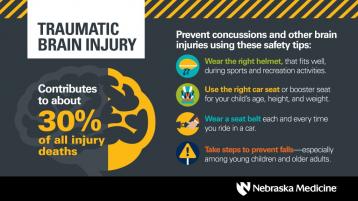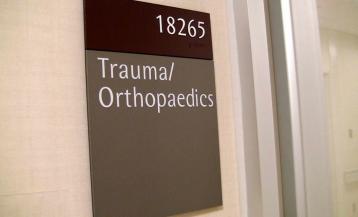
There are many causes of brain injury or traumatic brain injury (TBI), but the four most commonly reported causes are from falls, motor vehicle crashes, being struck by or against an object and assaults.
Falls: Falls were the leading cause of TBI (47 percent) in the United States in 2013. They cause more than half (54 percent) of all TBIs among children ages 0–14 years and 79 percent of all TBIs among adults aged 65 years and older.
Being struck by or against an object or person: This type of TBI occurs from being struck (hit) or crushed, or colliding with a moving or stationary object or person. These events account for 15 percent of all TBIs and are the second-leading cause of TBI among children aged 0–14 years (22 percent, or one in five incidents). Sports-related TBIs are one type of TBI that are the result of being struck by or against an object or person.
Motor vehicle traffic incidents: Among all age groups, motor vehicle crashes and traffic-related incidents are the third-leading cause of TBI (14 percent) and result in the largest percentage of TBI-related deaths (19 percent in 2013).
Assault: Assaults are the cause of 10 percent of TBIs in the general population; they account for 3 percent of all TBIs among children aged 0–14 years and 1 percent among adults ages 65 years and older. Assaults include injuries inflicted by another person with intent to injure or kill, such as fights, child maltreatment (e.g., shaken baby or abusive head trauma) and intimate partner violence or elder abuse.
Traumatic Brain Injury Statistics
In 2013, about 2.8 million emergency department (ED) visits, hospitalizations, or deaths were related to TBI, either alone or in combination with other injuries.
TBI-related ED visits for sports- and recreation-related injuries increased 33 percent from 248,418 in 2009 to 329,290 in 2012 among those 19 years old or younger.
The total cost of ED visits, hospitalizations and deaths related to TBIs, either alone or in combination with other injuries, exceeds $82 billion annually – this includes medical and work loss costs.
TBI may potentially affect:
Cognitive function (e.g., impaired attention or memory)
Motor function (e.g., extremity weakness or poor coordination and balance)
Sensation (e.g., loss of hearing, vision, perception or touch)
Emotion (e.g., depression, anxiety, aggression, loss of impulse control or personality changes)

Call your health care professional right away, call 911 or go to the nearest emergency department if you or someone you know has an injury to the head and you notice any of the items on this list:
- Appearing dazed or stunned
- Forgetting an instruction
- Moving clumsily
- Answering questions slowly
- Losing consciousness (even briefly)
- Showing mood, behavior or personality changes
- Being unable to recall events prior to and/or after a hit or fall
- Nausea or vomiting
- Balance problems or dizziness
- Double or blurry vision
- Sensitivity to light or noise
- Sensation of feeling sluggish
- Concentration or memory problems
- Confusion
- Not “feeling right” or “feeling down”
- Mood changes, such as irritability, sadness, nervousness, anxiety, or acting more emotional than normal
- Changes in sleep patterns
Help keep yourself and loved ones safe by:
- Wearing the right helmet, that fits well, during sports and recreation activities
- Using the right car seat or booster seat for your child’s age, height and weight
- Wearing a seat belt each and every time you ride in a car
- Taking steps to prevent falls – especially among young children and older adults
Source of information: Centers for Disease Control and Prevention (CDC), National Center for Injury Prevention and Control, Guide to Writing about Traumatic Brain Injury in News and Social Media.


